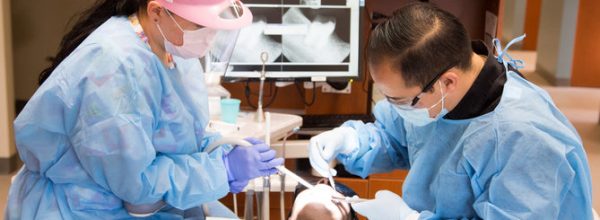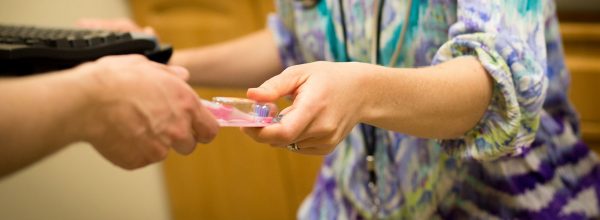California recently passed legislation to fund teledentistry for the underserved through Medi-Cal. The Pacific Center for Special Care at University of the Pacific’s Arthur A Dugoni School of Dentistry, through six years of research, has developed a model of community-based care using telehealth-connected dental teams to reach these populations at schools, community facilities and health centers.
Seeing the Problem
Less than half of California residents get regular oral health care through the traditional dental care system, particularly low-income children, institutionalized elderly, and disabled adults. As a result oral health problems among these populations have become epidemic. The problem, however, isn’t always cost: it’s access. Many low-income Californians qualify for Medi-Cal, which covers many basic dental procedures and oral health prevention practices. But, in many places and in rural areas in particular, oral health facilities and providers which accept Medi-Cal are rare and demand for their services can be overwhelming. A new model is needed to fully reach the underserved and build a culture of strong oral health prevention.
New World for Dental Policy
AB1174, a California bill signed into law in September, created a funding mechanism—the ability to bill Medi-Cal—for a model of providing dental care through teams of hygienists and dentists connected online and working outside of a dental office. The bill also expanded the scrope of practice for dental hygienists, including the registered dental hygienist in alterative practice (RDHAP). Now these providers do not need onsite supervision from a dentist to decide what x-rays to take or to apply a type of temporary filling called an Interim Theraputic Restoriations. The law empowers a community-based team teledenistry model pioneered through the Virtual Dental Home pilot program, and paves the way for others to use this model to provide care for underserved patients.
A Roaming Dental Home
The idea of the Virtual Dental Home model is to take preventative dental care out of the dentist’s office and integrate it into education, social services and primary health systems that touch otherwise hard-to-reach patients. This means sending a hygienist regularly to schools, Head Start preschools, long-term care facilities, group-homes for the disabled, community centers in low-income areas, health clinics, nursing homes, and potentially other locations where dentistry is difficult to access.
These hygienists, under a denist’s remote supervision, rotate from site to site with portable dental equipment that allows them to take x-rays and photos, as well as perform preventative and early intervention treatments. They provide oral health education and, when necessary, refer patients to dentists and specialists for advanced procedures. This additional care is then easier for patients to get because they go to the dentist with a care plan already developed.
How It Works
- Telehealth-connected dental teams consist of a dentist overseeing up to five remote hygienists—primarily a RDHAP, but potentially also a dental hygientist working in a public health program (RDH). Hygienists are often accompanied by a bilingual navigator, dental assistant or promotora.
- The hygienists, equipped with portable dental equipment (including x-ray an x-ray camera), travel to community-based locations to see patients that otherwise may have trouble accessing oral health services. The hygienist may visit several different locations each week, cycling between regular stops every week or month.
- Set up in a normal room without specialized dental apparatus, the hygienists can collect diagnostic records including medical and dental histories, photographs and x-rays and dental charting. They can also use their portable equipment to provide hygiene services and place fluoride varnish, and sealants.
- The complete set of electronic dental records are uploaded to a secure cloud-based server. These are reviewed by a dentist working remotely, who creates a treatment plan. Pacific’s experience is that approximately two-thirds of patients in s Virtual Dental Home system can be kept healthy in the community setting. The remaining third will need care provided by a dentist or specialist in a dental clinic, such as fillings or oral surgery.
- The hygienist, either that same day or on another visit, will carry out aspects of the treatment plan that can be conducted on site. These include education, risk assessment, preventive procedures such as cleanings, sealants or fluoride treatments, case management, and applying Interim Therapeutic Restorations.
- Patients who are referred to dental offices or specialists for additional care can then more easily make appointments, arriving with health records, x-rays and a diagnosis already prepared. This makes a successful and more efficient visit more likely.
Opportunities for Clinics
Safety net clinics are often able to reach patients that fall through the cracks of traditional healthcare establishments—including the dentist offices that serve most Americans. For federally qualified health centers, this policy change offers an opportunity to expand oral health services in ways that are more efficient, require less investment, and are better tuned to reach safety net patients.
Clinics without their own oral health facilities could use a telehealth-connected team to offer patients visits with hygienists at the clinic in any basic examination room. They could keep most patients healthy with these services and then refer those individuals needing more advanced dental services to clinics with dental facilities. For clinics that do have dental chairs, the clinic can become a home base for a dentist supervising a telehealth-connected team allowing them to expand access to more patients and better prioritize time in the dental chair. This model means diagnostic records, examinations, preventive and early intervention services, and education can happen in any community site, while visits with a dentist in a dental chair can be reserved only for procedures that need the equipment and expertise available in the clinic.
Lessons from Practice
Though the new policy limits a dentist’s telehealth supervision to five hygienists, the Virtual Dental Home pilot found that small team size was important for ensuring trust and calibration. This camaraderie is particularly important when the dentist and the hygienist are connected remotely, and need to be confident in each other’s skills and judgment.
What’s Next?
The new teledentistry regulations go into effect January 1, 2015. Dr. Paul Glassman, Director of the Pacific Center for Special Care says that Pacific is prepared to help health centers and other dental providers learn to use the Virtual Dental Home system of care to expand their reach beyond the walls of the clinic and spread the system beyond the pilot communities.
Learn More
The Pacific Center for Special Care is part of the the Arthur A. Dugoni School of Dentistry. They seek to advance better ways of improving oral health for the underserved. Learn more about the Virtual Dental Home pilot at www.virtualdentalhome.org
Find this useful or interesting? We’re constantly sharing stuff like this. Sign up to receive our newsletter to stay in the loop.



